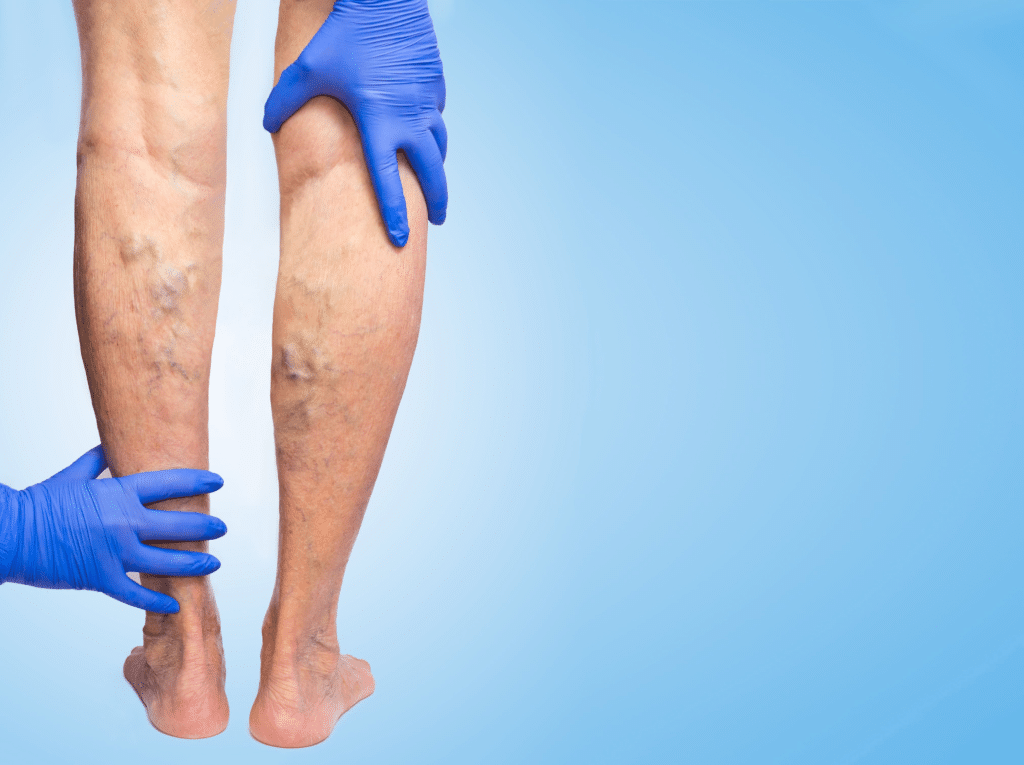Vein disease affects everyone differently. While one person may be at the first vein disease stage with only mild symptoms and a few spider veins, others may be at a different vein disease stage and have more significant symptoms. Symptoms across stages range in severity and occurrence, but in general, patients experience aching, swelling, and the development of ropey veins in the affected area. Vein doctors like Dr. Wright know for certain that vein disease stages will get worse if you don’t get treatment. Take a look at the six stages of vein disease below to determine where you fall, and take our vein quiz here.
Potential Causes for Vein Disease
While it may be an umbrella term, vein disease can refer to a variety of vein conditions and insufficiencies that have the potential to cause painful symptoms or more dangerous conditions for individuals down the road. Blood circulation is an essential bodily function for maintaining overall health, and keeping a close eye on vein health is a primary step in staying ahead of the potential for developing more complicated scenarios down the line. Physicians today can point to a variety of reasons that individuals may begin experiencing symptoms related to vein disease. While some individuals are prone to developing venous insufficiencies due to genetic predisposition and family history, others may find that their conditions are related to lifestyle choices or other linked ailments.
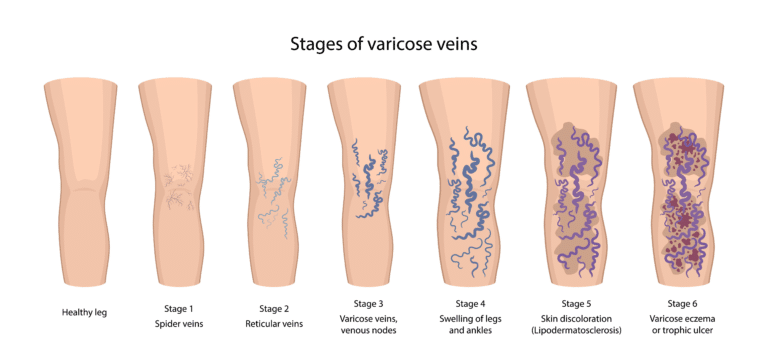
Circulatory issues can arise when blood flow is restricted due to extended periods spent sitting. Whether this happens due to a sit-down job or extensive time traveling on a plane, the less muscle contraction that occurs regularly, the higher the risk for developing circulatory issues related to veins and potentially deep vein thrombosis in the future. Obesity is another potential factor in developing vein disease, as added weight puts added pressure on the veins as they work hard to move blood throughout the body. Some individuals suffering from conditions such as heart failure or inflammatory bowel syndrome may also be at an increased risk for vein disease overall as blood flow is hindered or veins are irritated internally. Venous insufficiencies such as varicose veins or spider veins are often correlated with age as well as hormonal fluctuations that occur during pregnancy or menopause.
The Six Stages of Vein Disease
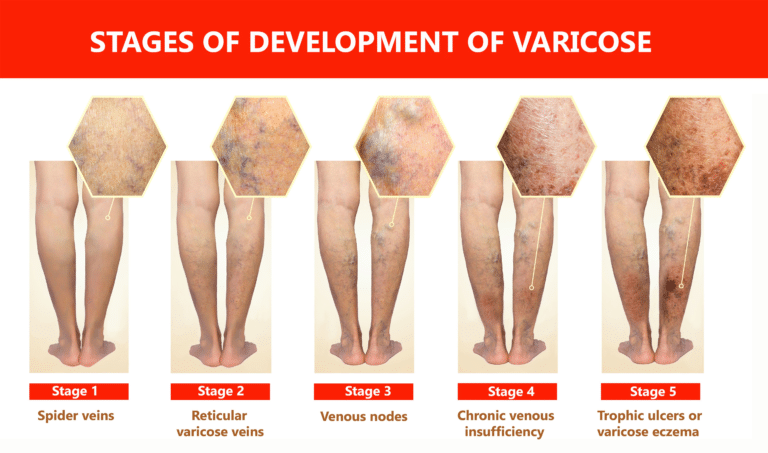
Vein Disease Stage 1: Spider Veins
This is the most mild form of vein disease. In short, this describes a disease that occurs in tiny veins in the skin. The dilated veins and capillary vessels are called telangiectasias and are more commonly called “spider veins.” They occur in 40% of women and 18% of men. Over half of the population has symptoms associated with this vein disease stage.
Vein Disease Stage 2: Varicose Veins
This is the classification for large, dilated varicose veins. In this stage, people often become aware of the vein disease. Over 75% of people at this stage have symptoms that interfere with their lives, such as aches in the affected area.
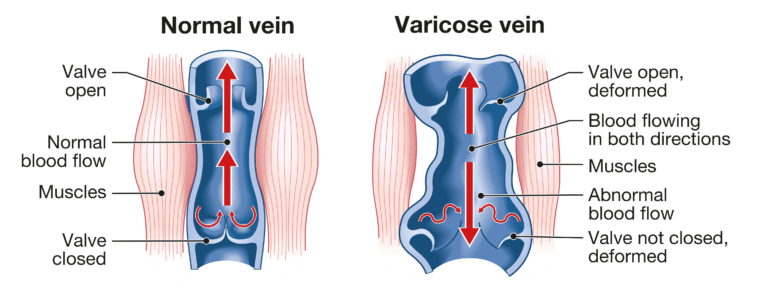
Vein Disease Stage 3: Swelling
Slightly more advanced vein disease in the legs causes swelling. The backflow in the venous system interferes with the body’s ability to reabsorb fluid. This leads to swelling of the leg. The swelling typically resolves at the end of the day when the patient elevates their legs. Vein disease is the most common cause of leg swelling.
Vein Disease Stage 4: Skin Changes
Over time, venous congestion leads to changes in the appearance of the skin. The skin becomes thinner and discolored to reddish-brown or whitish in color. During this vein disease stage, the patient can easily injure the skin, and wounds heal slowly.
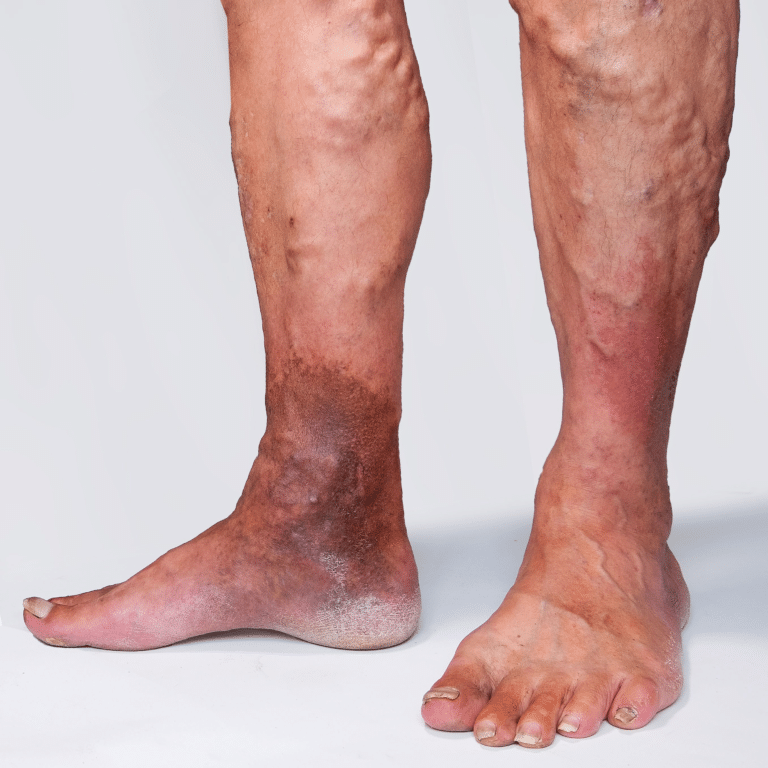
Vein Disease Stage 5 & 6: Leg Ulcers
These are the most advanced forms of superficial vein disease. In this case, venous congestion causes venous ulcers. The congestion has now progressed, and it interferes with the ability of blood flow to provide nutrition to the skin. This makes any skin injury heal very slowly, if at all. If you don’t receive treatment for the underlying vein disease, 20% of these ulcers remain unhealed for two years.
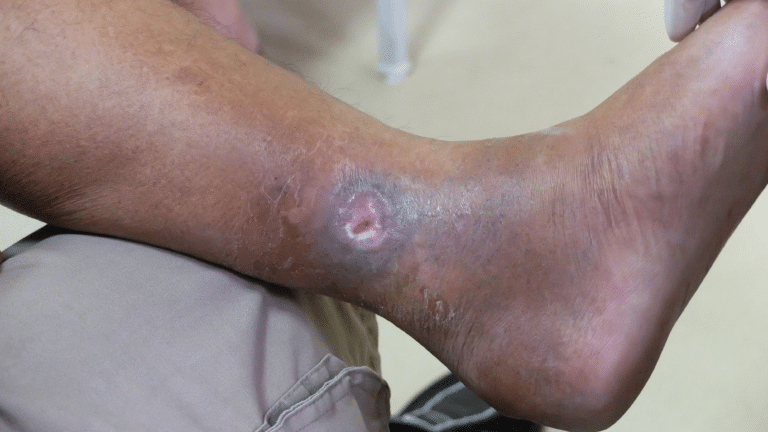
We describe “Class 5 Vein” as legs with healed venous ulcers and “Clinical Class 6 Vein Disease” as legs with active ulcers. Unfortunately, many people with leg ulcers don’t know that we can effectively treat them.
Treating Vein Disease
Chronic venous disease presents in a variety of stages in patients and, therefore, requires a treatment plan that is customized to the individual. While in the past, it was often assumed that highly invasive treatment techniques such as vein stripping were the only way to handle the venous disease successfully, today, advancements in the field of medicine and cosmetic treatment options provide patients with a wide variety of minimally-invasive choices. These outpatient treatment options eliminate the need for lengthy surgeries accompanied by plenty of risks associated with the use of general anesthesia. Instead, patients find they have the option of utilizing local anesthetic and enjoying treatments that come with short and relatively painless recovery periods.
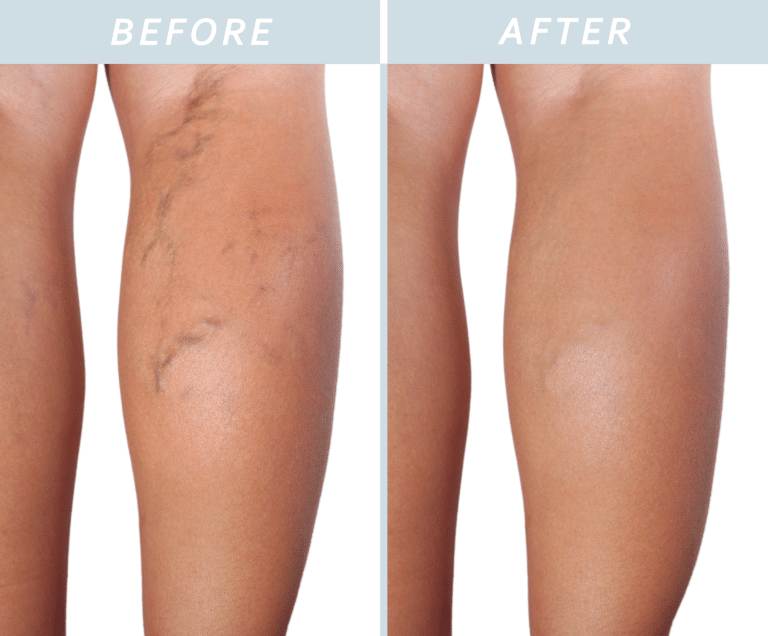
Patients suffering from mild cases of the chronic venous disease will likely find wearing compression garments regularly to be highly successful. From socks to sleeves, these compression garments work to promote healthy blood flow in the extremities and, when combined with lifestyle changes such as diet and exercise, can prove to be highly effective.
Those patients suffering from more severe cases of chronic venous disease may need to consider minimally invasive treatment options such as laser ablation or sclerotherapy. These treatments are often performed over a series of sessions and involve collapsing problematic veins using injections or laser-focused heat.
Vein Treatment Cost Considerations
It may be surprising to patients that in many cases, the cost of care for the chronic venous disease may be covered by their insurance provider. Unlike cosmetic treatment options for conditions such as spider veins, chronic venous disease can have long-term medical impacts on an individual. Treatment may be the best way to maintain a high quality of life later on. In light of this, it’s important for prospective patients to make sure to check with their insurance provider before undergoing treatment for chronic venous disease to see what might be covered. As with any medical treatment, the final cost will depend not only on the severity of the case being treated but the number of sessions required to achieve successful results.
Contact St. Louis Laser Veins Today
When you’re considering the many benefits of treatment options for vein disease or venous insufficiencies or are perhaps looking to establish care for preventative vein health, Dr. Wright and his team are ready and waiting to partner with you. Contact our team today to learn more about our many available services and schedule your complimentary initial consultation. This important time is set aside for Dr. Wright to get to know each patient’s individual story and to begin putting together a plan for keeping vein health based on a health profile and patient preferences. From varicose veins to spider veins and the many potential conditions in between, Dr. Wright brings vast experience into the world of vein health and a passion for creating a safe and effective place for patients to find the care they need.
